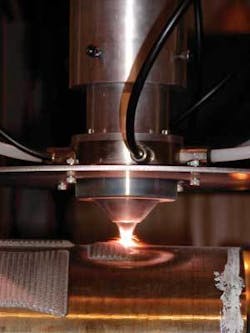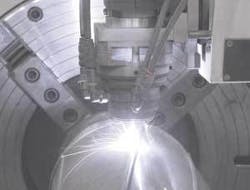OPTOELECTRONIC APPLICATIONS: Materials Processing - Diode lasers test their mettle in surface treatment

Most everyone has heard the old adage, “If it ain’t broke, don’t fix it.” But history has repeatedly demonstrated that technology advances can often improve a process or outcome we didn’t even realize needed fixing. (Then it’s just a matter of waiting until it becomes affordable.)
Advances in high-power diode lasers are a case in point, especially when it comes to materials processing. During the past 20 years, multimode diode-laser bars and individual single-emitter diode devices have achieved increasingly higher output powers and better power-conversion efficiencies, allowing semiconductor lasers to evolve from the scientific arena into true industrial tools. In fact, interest in direct-diode materials processing has been a key factor in the development of high-power diode lasers. While diode lasers are still a few years away from being practical ablation or cutting tools for heavy metals, they are gaining traction in materials-processing applications in which beam quality and brightness are not critical to the outcome, such as surface treatment.
Surface treatment is one of the most efficient uses of laser energy and one of the most controllable heating processes when working with metal components. Laser-based techniques such as heat treating, cladding, alloying, and welding have become well-established in the automotive, aerospace, energy, defense, and machine-tool industries for applications ranging from increasing wear resistance of turbine blades to improving corrosion resistance and performance in car engines. Historically, these applications have been served by Nd:YAG and CO2 lasers, both of which are well-accepted materials-processing tools. Displacing these lasers would require a solution that brings not only operational but financial advantages.
This is where high-power diode lasers come in. While engineers continue to work out a few remaining kinks—such as how to offset the thermal issues that arise in a compact package as it churns out 3 to 4 kW of power in a single shot-the diode laser offers a number of advantages for industrial surface-treatment applications as compared to the Nd:YAG or CO2 laser. In particular, the shorter wavelength of the diode laser enables much better absorption of the laser energy, leading to an overall lower power requirement for surface treatment applications. A diode-laser cladding system can typically perform cladding with half as much laser power as a CO2 laser (see table). The diode laser typically has 25% to 30% wall-plug efficiency, compared to about 10% for the CO2 and the Nd:YAG laser. In addition, the diode laser can be fiber-delivered, which makes it more attractive for automated applications. Also, there is no need to precoat the metal to increase absorption—a necessity with the CO2.
| CO2 | Nd:YAG (diode pumped) | Diode | |
|---|---|---|---|
| Required laser power | 5 kW | 3 kW | 3 kW |
| Average wall-plug efficiency | 10% | 10% | 30% |
| Approximate electrical power consumption of the lasers | 50 kW | 30 kW | 10 kW |
| Electrical power cost per hour @0.09$/kWh | 4.50 $/h | 2.70 $/h | 0.90 $/h |
| Source: Fraunhofer | |||
“Most laser-cladding operations use the CO2 laser, but there are inherent disadvantages compared to the diode laser or other lasers with the same wavelength as the diode,” said Eric Stiles, laser-division manager at the Fraunhofer Center for Coatings and Laser Applications (Plymouth, MI). “But the diode laser is interesting for applications like cladding because of the low cost for kilowatt power. A 3 to 4 kW diode-laser system can do the same work as a 6 to 8 kW CO2-laser system because a lot of the energy of the CO2 is lost. With the diode you get much better absorption with a lot of materials, especially at lower power intensities where CO2 absorption is poor.”
Pros and cons
Despite these advantages, however, diode lasers still need further refinement in terms of being reliable enough for intensive industrial applications like laser cladding, a process in which laser energy is used to melt or weld a metallic or ceramic powder onto a substrate to create a wear- or corrosion-resistant layer on a metal component (see Fig. 1). While the current generation of high-power diode lasers has resolved many of the reliability issues that plagued earlier generations, random failures remain a problem when a diode-laser system is used in high-volume production applications, particularly when pulsing is required. Thus, while the overall cost of an industrial diode-laser system should be lower, the need to replace the diodes more frequently disrupts production cycles and increases overall cost of ownership.
“The main specificity of this market [materials processing] is the operating regime,” Franck Leibreich, director of marketing at Newport’s Spectra-Physics Lasers Division (Mountain View, CA). “Long micropulses—one second on, one second off—is the most difficult operating regime for the diode because it stresses the diode very much, which leads to random failures. So we and others are working to make the lasers more robust by focusing on the interaction between the soldering material and the heat sink in order to compensate for the coefficient of expansions. The goal is to optimize the thermal exchange between the materials.”
Brightness is another factor. According to Leibreich, the need to transform inherently low-brightness, highly asymmetric diode lasers has led to the development of several important beam-shaping and beam-combining technologies (see www.laserfocusworld.com/articles/250394). As a result, diode-laser devices that produce 4 kW from a 600-µm-diameter-core fiber are now being used in applications such as cladding and annealing.
“As diode lasers continue to evolve, we can predict that there are two areas where this technology will grow in attraction for industrial applications,” said Phillip Anthony, manager, macro business unit at Rofin-Sinar (Plymouth, MI). “The life of the diodes and diode bars will get longer, and as this happens the long-term cost of ownership becomes less of an issue. Second, a lot of time and energy is being spent on improving the beam quality, which should lead to becoming more realistic for fiber delivery. In the end this will be driven by the cost of ownership and the predictable life of the diode that can be measured in tens of thousands of hours.”
The real world
While efforts are under way to improve the reliability and lifetimes of diode lasers, some companies and organizations are already demonstrating the efficacy of this technology for surface treatment. At Fraunhofer, for example, Stiles and his colleagues have developed a new cladding process that utilizes a 3 kW Rofin-Sinar direct diode laser and a coaxial powder-feeding nozzle. It was initially tested in the oil industry, in which new wear-protective hard coatings were developed, tested, and applied to a number of down-hole drilling tools.
On the commercial front, Nuvonyx (Bridgeton, MO) and Laserline (Mülheim-Kärlich, Germany) have both had some success with their diode-laser cladding systems (see Fig. 2). Nuvonyx, founded in 1998 by former employees from the McDonnell/Douglas Laser Systems Division, has been a pioneer in the commercial introduction of high-power direct-diode and fiber-coupled laser systems for industrial applications in aerospace and defense. In 2005 Nuvonyx was acquired by ICx Technologies, which then acquired Thales Laser Diode (Orsay, France), which has since become Nuvonyx Europe. The company’s newest product, introduced in June 2006, is a fiber-coupled diode-laser system with an optical power density of more than 1 MW/cm², which the company says is an order of magnitude higher than any other commercially available system operating at a single wavelength.Laserline’s expertise is also in fiber-delivered high-power diode lasers up to 6 kW. According to Klaus Kleine, vice president of U.S. operations, Laserline is beginning to see diode-laser cladding systems replacing CO2 and Nd:YAG lasers in industrial applications, particularly in the United States. While the aerospace and power-plant industries continue to account for the bulk of laser-cladding applications, Kleine says there is a big push under way in other industries and that the compactness, efficiency, and affordability of the diode-laser systems should begin to attract more customers.
“The automotive applications are much more prevalent in Europe, which is also at the forefront of installed diode-laser systems for surface treatment,” he said. “A lot of these advances are being pushed by diesel-engine technology; the goal (in Europe) is to make diesel engines cleaner and much more fuel efficient via surface treatment.”
Kathy Kincade | Contributing Editor
Kathy Kincade is the founding editor of BioOptics World and a veteran reporter on optical technologies for biomedicine. She also served as the editor-in-chief of DrBicuspid.com, a web portal for dental professionals.
